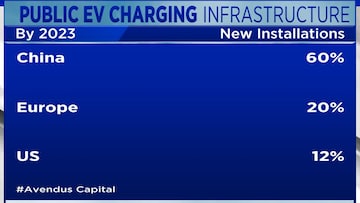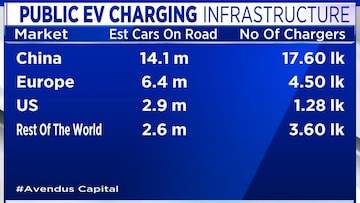While India’s electric vehicle sales crossed the one million mark in the 2022-23 fiscal, Koushik Bhattacharyya, Managing Director and Head, Industrials Investment Banking at Avendus Capital says the public charging infrastructure has grown 10 times in the past year.
Bhattacharyya is of the view that given the current penetration of EVs, India’s charging infrastructure is healthy. In fact, it stacks off better than some of the countries because it is cars per charger and it’s a reflection of low penetration and not a very robust charging infrastructure. Therefore, a lot of distance needs to be covered on EV charging, he said, adding that by 2030 India would require one million EV chargers.
“We ended 2021 with about a little over 1,000 chargers, now, we have almost 11,000 chargers, and this is a very small number compared to what we will eventually need when the penetration of EVs is at a steady state.
“Our estimate is that by 2030, when some of the categories would have reached over 50 percent EV penetration, India would require almost a million chargers or slightly higher than that,” he told CNBC-TV18 on July 18.
He explained that many private operators, with the support of the government, are looking to set up businesses, which will cater to this market.
The four-wheeler EV penetration in India currently stands at a little over a percent and as that increases, more public chargers would be required, he explained.
“The government is taking an indirect support approach there. Apart from putting a small outlay in FAME-II, which is yet to be deployed, and to be used up before FY24 concludes, a couple of other ways in which it can help the charging infrastructure is by making the grid more robust and more green,” he said.
Secondly, Bhattacharyya said, the government can also standardize some of the charging standards at a connector level, so that there could be an uniform charging infrastructure which could be used by various OEMs.
However, Jeetender Sharma, Managing Director and Founder at Okinawa Autotech, pointed out that compared to the other parts of the world, India is behind in terms of numbers – seven cars per charging station, which means a lot needs to be done.
Not just the government but aggregators and target players are working together in order to bring in more business models in such a way that more charging stations can be created across the country, he said.
Sharma, however, explained that those involved in two two-wheeler EVs are not as much concerned about charging stations. “In case of Okinawa and other players also, we have a detachable battery, and people have the ease to charge their battery at their own convenience.”
Meanwhile, Samir Arora of Helios Capital explained that someone who is supplying only to the EV side will be a big beneficiary of the charging system.
“Those who are making ICE cars are now forced to make EV cars and for them it's destroying of the capital but somebody who's a direct beneficiary or supplying only to the EV side or part of the new story of EV, independent of having to switch from ICE to this, they will be big beneficiaries and charging and other things and anybody associated with it will have good growth over time,” he said.
It may be noted that earlier this month, Federation of Automobile Dealers Associations of India (
FADA) said auto retail outlook for July suggests that the reduction in FAME subsidies casts a shadow over electric vehicles sales.
Watch the accompanying video for more






